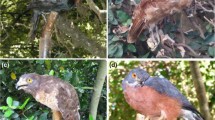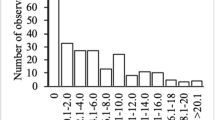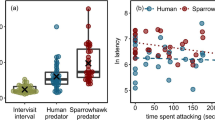Abstract
There is growing evidence that birds are able to discriminate different types of nest intruders and adjust their nest defence behaviour according to intruder dangerousness and distance from the nest (the dynamic risk assessment hypothesis). Here, we tested whether birds’ decisions about nest defence may additionally be affected by an increasing familiarity with a particular nest predator. We tested nest defence responses of great reed warblers Acrocephalus arundinaceus to a nest predator, the little bittern Ixobrychus minutus. Great reed warbler nests located close (≤7 m) to synchronously breeding little bitterns were “neighbour”, other nests were “solitary”. Great reed warbler specific aggression towards a little bittern dummy was much lower (~5-times) at neighbour than solitary nests. In contrast, generalised responses to a control innocuous intruder (the turtle dove, Streptopelia turtur) were statistically identical at neighbour and solitary nests. These patterns are in line with dynamic risk assessment hypothesis. We hypothesise that decreased great reed warbler aggression at neighbour nests also represents a specific behavioural adaptation to nesting in association with the little bittern. Little bitterns breeding closer to great reed warblers showed decreased risks of failure due to predation. However, further research is needed to experimentally test the causal links behind these patterns.


Similar content being viewed by others
References
Amini Nasab SM, Behroozi Rad B, Riahi Bakhtiari AR (2006) Some of the effective factors on the nesting-site selection of breeding birds in Zarrinkola permanent Ab-bandan, Mazandaran Province. Iran J Nat Res 59:471–485
Campobello D, Sealy SG (2010) Enemy recognition of reed warblers (Acrocephalus scirpaceus): threats and reproductive value act independently in nest defence modulation. Ethology 116:498–508
Campobello D, Sarà M, Hare JF (2012) Under my wing: lesser kestrels and jackdaws derive reciprocal benefits in mixed-species colonies. Behav Ecol 23:425–433
Čapek M, Požgayová M, Procházka P, Honza M (2010) Repeated presentations of the common cuckoo increase nest defence by the Eurasian reed warbler but do not induce it to make recognition errors. Condor 112:763–769
Caro T (2005) Antipredator defenses in birds and mammals. University of Chicago Press, Chicago
Conover MR (1987) Acquisition of predator information by active and passive mobbers in ring-billed gull colonies. Behaviour 102:41–57
Curio E, Klump G, Regelmann K (1983) An anti-predator response in the great tit (Parus major): is it turned to predator risk? Oecologia 60:83–88
Dyrcz A, Witkowski J, Okulewicz J (1981) Nesting of “timid” waders in the vicinity of “bold” ones as an antipredator adaptation. Ibis 123:542–545
Fournier DA, Skaug HJ, Ancheta J, Ianelli J, Magnusson A, Maunder M, Nielsen A, Sibert J (2012) AD Model Builder: using automatic differentiation for statistical inference of highly parameterized complex nonlinear models. Optim Methods Softw 27:233–249
Ghalambor CK, Martin TE (2001) Fecundity-survival trade-offs and parental risk-taking in birds. Science 292:494–497
Grafen A, Hails R (2002) Modern Statistics for the Life Sciences. Oxford University Press, Oxford
Grim T (2005) Host recognition of brood parasites: implications for methodology in studies of enemy recognition. Auk 122:530–543
Grim T (2008) Are blackcaps (Sylvia atricapilla) defending their nests also calling for help from their neighbours? J Ornithol 149:169–180
Grim T, Samaš P, Moskát C, Kleven O, Honza M, Moksnes A, Røskaft E, Stokke BG (2011) Constraints on host choice: why do parasitic birds rarely exploit some common potential hosts? J Anim Ecol 80:508–518
Hobson KA, Bouchart ML, Sealy SG (1988) Responses of naïve yellow warblers to a novel nest predator. Anim Behav 36:1823–1830
Honza M, Šicha V, Procházka P, Ležalová R (2006) Host nest defence against a color-dimorphic brood parasite: great reed warblers (Acrocephalus arundinaceus) versus common cuckoos (Cuculus canorus). J Ornithol 147:629–637
Honza M, Procházka P, Šicha V, Požgayová M (2010) Nest defence in a cuckoo host: great reed warblers risk themselves equally for their own and parasitic chicks. Behaviour 147:741–756
Hudec K (1994) Ptáci—Aves, vol 1, 2nd edn. Academia, Praha
Kleindorfer S, Fessl B, Hoi H (2005) Avian nest defence behaviour: assessment in relation to predator distance and type, and nest height. Anim Behav 69:307–313
Krams I, Krama T, Igaune K, Maend R (2007) Long-lasting mobbing of the pied flycatcher increases the risk of nest predation. Behav Ecol 18:1082–1084
Kryštofková M, Haas M, Exnerová A (2011) Nest defence in blackbirds Turdus merula: effect of predator distance and parental sex. Acta Ornithol 46:55–63
Leisler B, Schultze-Hagen K (2011) The reed warblers. Diversity in a uniform bird family. KNNV, Zeist
Lima SL (2009) Predators and the breeding bird: behavioral and reproductive flexibility under the risk of predation. Biol Rev 84:485–513
Lombardi CM, Hurlbert SH (2009) Misprescription and misuse of one-tailed tests. Austral Ecol 34:447–468
Montgomerie RD, Weatherhead PJ (1988) Risks and rewards of nest defence by parent birds. Q Rev Biol 63:167–187
Neudorf DL, Sealy SG (1992) Reactions of four passerine species to threats of predation and cowbird parasitism: enemy recognition or generalized responses? Behaviour 123:84–105
Nuechterlein GL (1981) Information parasitism in mixed colonies of western grebes and Forster terns. Anim Behav 29:985–989
Orians GH, Wilson MF (1964) Interspecific territories of birds. Ecology 45:736–745
Pardo-Cervera F, Sørensen IH, Jensen C, Ruiz X, Sánchez-Alonzo C (2010) Breeding biology of the little bittern Ixobrychus minutus in the Ebro Delta (NE Spain). Ardeola 57:407–416
Polak M (2013) Comparison of nest defence behaviour between two associate passerines. J Ethol 31:1–7
Post W, Seals CA (1993) Nesting associations of least bitterns and boat-tailed grackles. Condor 95:139–144
Quinn JL, Ueta M (2008) Protective nesting associations in birds. Ibis 150:146–147
Quinn JL, Prop J, Kokorev Y, Black JM (2003) Predator protection or similar habitat selection in red-breasted goose nesting associations: extremes along a continuum. Anim Behav 65:297–307
R Core Team (2012) R: a language and environment for statistical computing. R Foundation for Statistical Computing, Vienna. http://www.R-project.org/. Accessed 13 Jan 2014
Richardson DS, Bolen GM (1999) A nesting association between semi-colonial Bullock’s orioles and yellow-billed magpies: evidence for the predator protection hypothesis. Behav Ecol Sociobiol 46:373–380
Rytkönen S, Soppela M (1995) Vicinity of sparrowhawk nest affects willow tit nest defense. Condor 97:1074–1078
Samraoui F, Nedjah R, Boucheker A, Alfarhan AF, Samraoui B (2012) Breeding ecology of the little bittern Ixobrychus minutus in northeast Algeria. Bird Study 59:496–503
Sealy SG, Neudorf DL, Hobson KA, Gill SA (1998) Nest defence by potential hosts of the brown-headed cowbird: methodological approaches, benefits of defense, and coevolution. In: Rothstein SI, Robinson SK (eds) Parasitic birds and their hosts: studies in coevolution. Oxford University Press, New York, pp 194–211
Strnad M, Němec M, Veselý P, Fuchs R (2012) Red-backed shrikes (Lanius collurio) adjust the mobbing intensity, but not mobbing frequency, by assessing the potential threat to themselves from different predators. Ornis Fenn 89:206–215
Trnka A, Grim T (2013a) Color plumage polymorphism and predator mimicry in brood parasites. Front Zool 10:25
Trnka A, Grim T (2013b) To compensate or not to compensate: testing the negotiation model in the context of nest defense. Behav Ecol 24:223–228
Trnka A, Prokop P (2010) Does social mating system influence nest defence behaviour in great reed warbler (Acrocephalus arundinaceus) males? Ethology 116:1075–1083
Trnka A, Prokop P (2012) The effectiveness of hawk mimicry in protecting the cuckoos from aggressive hosts. Anim Behav 83:263–268
Trnka A, Prokop P, Batáry P (2010) Infanticide or interference: does the great reed warbler selectively destroy eggs? Ann Zool Fenn 47:272–277
Trnka A, Prokop P, Grim T (2012) Uncovering dangerous cheats: how do avian hosts recognize adult brood parasites? PLoS ONE 7:e37445
Veen T, Richardson DS, Blaakmeer K, Komdeur J (2000) Experimental evidence for innate predator recognition in the Seychelles warbler. Proc R Soc Lond B 267:2253–2258
Wiebe KL (2004) Innate and learned components of defence by flickers against a novel nest competitor, the European starling. Ethology 110:779–791
Zuur AF, Hilbe JM, Ieno EN (2013) A beginner’s guide to GLM and GLMM with R. Highland Statistics, Newburgh
Acknowledgments
We are grateful to D. Campobello, P. Samaš and two anonymous referees for helpful comments on this work. P. Samaš also helped with statistical analyses. When writing the draft, T.G. was supported by Human Frontier Science Program award (RGY83/12).
Author information
Authors and Affiliations
Corresponding author
About this article
Cite this article
Trnka, A., Grim, T. Dynamic risk assessment: does a nearby breeding nest predator affect nest defence of its potential victim?. J Ethol 32, 103–110 (2014). https://doi.org/10.1007/s10164-014-0400-x
Received:
Accepted:
Published:
Issue Date:
DOI: https://doi.org/10.1007/s10164-014-0400-x




